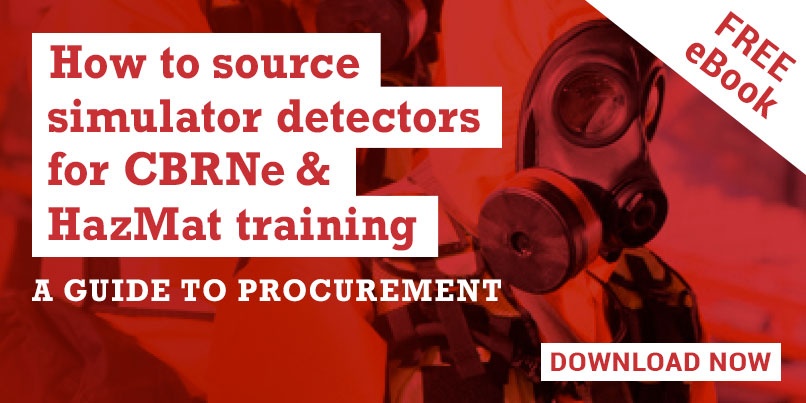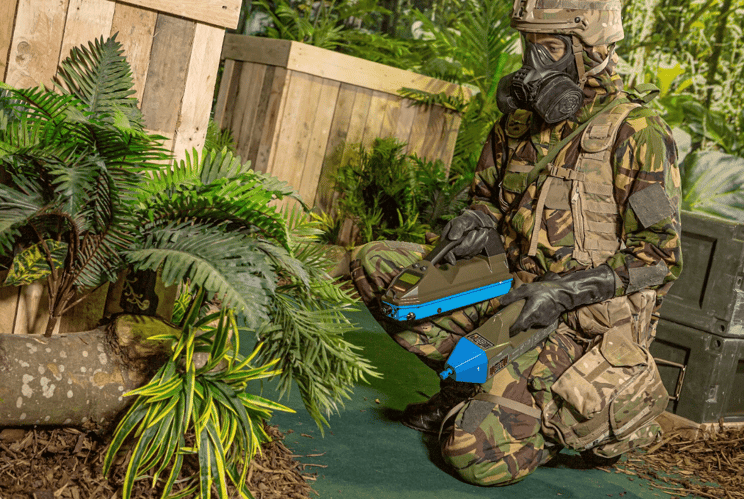
For many incidents involving specialist CBRNe or HazMat teams, standard protocol may dictate the practice of orthogonal detection, or the use of multiple pieces of equipment to rule out potential false positives.
In this article, we will explore orthogonal detection, including its merits and shortcomings, and how these translate to specialist CBRNe and HazMat training. We will then outline the potential benefits of using simulator detectors over traditional methods involving live agents and simulants, and highlight simulator detectors to consider for training.
Why Orthogonal Detection Is Important During CBRNe and HazMat Response
When attending an incident that could potentially involve toxic industrial chemicals and/or chemical warfare substances, orthogonal detection may be necessary for more accurate scene assessment and measurements.
Much like asking a doctor for a second opinion about a diagnosis, orthogonal detection of potentially toxic or dangerous substances can increase the quality of the overall analysis. It reduces risk in a cost-effective manner, as more advanced tools, such as a typical GC/MS, will cost about twelve to twenty times as much as a standard detector.
.png?width=329&height=501&name=Screenshot%202023-08-02%20at%2011.05.0%20(2).png)
Orthogonal detection is especially important when responding to incidents in public spaces, such as airports, or when searching suspected clandestine laboratories in residential areas as false negative alarms with IMS detectors can be set off through the detection of cologne, cleaning products, and even deep heat treatments such as Bengay or Ralgex.
However, it is also important to note the limitations of orthogonal detection. For example, utilising two types of detection technology will not expand the identification capability beyond that of each detector, and the orthogonal capability only extends to those substances which both detectors can accommodate.
→ Related: A Guide to the Five Levels of HazMat Response
The Use of Simulant Training for Orthogonal Detection
Traditionally, CBRNe and HazMat instructors tasked with training students for orthogonal detection have opted for simulants, or substances that create a “false positive” reading on their detectors.
Students are then tasked to screen out these false positives using their detection equipment. For example, a substance that causes a false positive on an IMS-based detector, such as a RAID M100 or LCD3.3 / M4A1 JCAD, is highly unlikely to cause a reading on a flame photometry-based detector, such as an AP4C. This allows the students to experience the benefits of orthogonal detection in action.
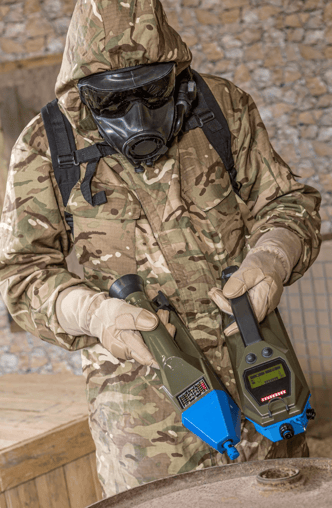
There are, however, significant limitations with the simulant agent approach. It can be a challenge to find suitable safe, environmentally friendly chemicals that will replicate the desired orthogonal detection characteristics. Also of note is the importance of logistical pre-planning, especially for chemical warfare agent EOD missions which might include pre cursors as well as CWAs. HazMat and CBRNe instructors must balance the limitations of utilising safer chemicals with the necessity of delivering real-experience training using key detectors.
The Benefits of Using Simulator Detectors During Orthogonal Detection Training Sessions
While simulants have traditionally been an option for delivering HazMat and CBRNe orthogonal training, their limitations may in many circumstances override their benefits.
Simulators and their associated simulation sources, on the other hand, are much easier to configure for detailed scenarios. For example, instructors have the ability to generate independent Nerve (G) and Blister (H) readings on an IMS-based simulator detector and Phosphorous (P) or Sulphur (S) readings on a flame photometry-based simulator detector.
Each appropriately configured simulation source would be located in an area that would be relevant to the potential reading (for example, a workshop or a cleaning substance store area).
A separate simulation source can then be placed to specifically represent a chemical that would provide a G reading on an IMS detector such as LCD3.3 / M4A1 JCAD or RAID M100 simulator (including the specific identity such as GB, GD, GF) and a reading on the P channel of an AP4C simulator. If desired a MultiGAS simulator can also be included in the exercise. The simulation technology also has the potential to be implemented within a mass spectrometer.
→ Related: How to Create Realistic HazMat First Responder Training Scenarios
Types Of Simulator Detectors To Consider
Choosing simulator detectors for orthogonal detection training depends largely on the equipment the students will be using when responding to real incidents. Responders working with an IMS-based detector such as the RAID M100 would, for example, need to work with a RAID M100-SIM.
To source the right training equipment, you must first identify a supplier who understands the manner in which, and reasons why, different detector types are deployed. A supplier must have an appropriate hazard simulation architecture to implement these scenarios, and most importantly, they must have strong relationships with the manufacturers of the actual detectors.
Argon simulators include a means by which instructors can remotely trigger the depletion of consumables, including batteries to ensure students plan for every contingency.
Listed below are some of the more common simulator detectors utilised in orthogonal detection training, and important notes for their use:
IMS–based Detectors:
M4A1 JCAD-SIM/ LCD3.3-SIM Chemical Hazard Detection Simulator
The M4A1 JCAD-SIM and LCD3.3-SIM detector simulators respond to electronic sources that simulate CWA, TICs and false positives. This removes the need for simulants which can harm the environment, saturate the training area, or pose potential health and safety risks. Scenarios can be set up anywhere, including within public buildings, in less than ten minutes.
Both the LCD3.3-SIM and M4A1 JCAD-SIM are designed to be fully compatible with the Argon PlumeSIM system (read more about PlumeSIM below).
When using the LCD3.3 and M4A1 JCAD-SIM detectors independently, the user must ensure that the required mode is set (for example, CWA and TICs, CWA-only or Survey Mode). They must also ensure that the confidence test is correctly carried out, and that spare simulation sieve packs are available should the simulated sieve pack depletion indication activate.
RAID M100-SIM
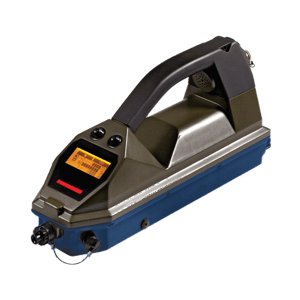
The Bruker Nano Analytics’ RAID-M100 detector training simulator provides military and civil CBRNe responders with a unique combination of features for training in the correct use of the Bruker RAID M / RAID M100 in virtually any scenario and environment.
Instructors can define the simulated threat to represent specific CWAs, such as GB, GD, GF, and HD. The instrument will indicate that specific threat when the student locates the simulation source.
Consumables are also simulated, enabling students to learn the importance of changing the RAID M100 sieve pack and drying filter.
As with the M4A1 JCAD-SIM and LCD3.3-SIM detector simulators, the RAID-M100-SIM is fully compatible with the PlumeSIM.
To get the most out of the RAID M100-SIM, it must be correctly prepared and configured for use in orthogonal detection training environments. The correct mode and library must be selected, confidence tests completed, and availability of spare simulation sieve packs and drying packs. Also importantly, ensure that the battery is fully charged
Flame photometry-based detector:
AP4C-SIM
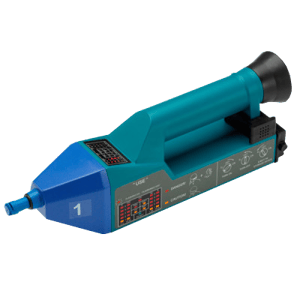
The AP4C-SIM simulation training system for the Proengin AP4C responds to safe electronic sources that simulate chemical vapours, toxic industrial substances or false positives.
As with the previously mentioned simulator detectors, the AP4C-SIM responds to safe, environmentally friendly electronic simulation sources. Users can simply set their simulation sources to provide readings on the HNO, CN and AS channels.
The AP4C-SIM is compatible not only with the PlumeSIM, but also with other simulators manufactured by Argon Electronics, including CAMSIM, LCD3.2e-SIM, LCD3.3-SIM, RAID-M100-SIM and the S4PE-SIM. This allows for multi-detector, multi-substance orthogonal training to take place within the same scenario
MultiGAS-SIM
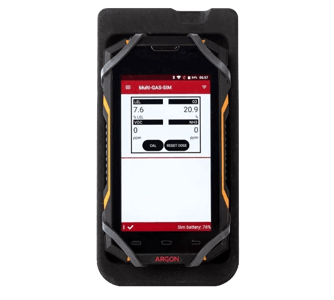
With the variety of Multi-Gas detectors available worldwide, it is reasonable to expect that one might be used during situations involving orthogonal detection. The MultiGAS-SIM offers the ability to train for such instances with the same foundational audio and visual indications of multiple gases as the real detectors.
The powerful combination of the Android-supported MultiGAS-SIM App and interface module permits the detector to respond to independently deployed Long Range Vapor Source (LRVS) gas emitters.
These LRVS are easy to use and programmable to represent a wide range of hazardous substances and scenarios that require orthogonal detection. The gas emitters issue a signal that can be detected at up to 25 meters (80 feet) distance in free space. This allows the simulated readings to increase as the student approaches the hazardous area and to reduce as they withdraw.
The MultiGAS-SIM’s “whole-life” cost of ownership is low, as it requires no consumables, regular calibration, or preventative maintenance, except to ensure readily available commercial AA batteries.
And as with previously mentioned detector simulators, the MultiGAS-SIM is fully compatible with PlumeSIM.
The PlumeSIM®/PlumeSIM® SMART Wide Area Training System
The PlumeSIM® and the PlumeSIM® SMART are a wide-area instrumented training systems that provide instructors with streamlined management of detector simulators that respond to a wide variety of user-defined orthogonal detection scenarios in real time.
While orthogonal scenarios are usually based upon the deployment of discrete physical simulation sources, PlumeSIM® and the app-based PlumeSIM SMART® allow for wide-area scenarios to also be created in exactly the same way.
When setting up any orthogonal detection training scenario, preparation and the right equipment are essential. Utilising traditional simulants can be helpful in some circumstances, however, simulator detectors offer increased flexibility and safety.
To learn more about sourcing simulator detectors for CBRNe and HazMat training, download our free ebook: How to Source Simulator Detectors for CBRNe and Hazmat Training.


